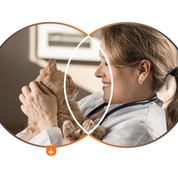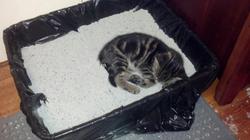 One of the easiest things about owning a cat is that you don’t have to take it outside every time it has to use the bathroom – but one of the hardest things about owning a cat is figuring out why it suddenly doesn’t want to use its super-convenient litterbox any more.
One of the easiest things about owning a cat is that you don’t have to take it outside every time it has to use the bathroom – but one of the hardest things about owning a cat is figuring out why it suddenly doesn’t want to use its super-convenient litterbox any more.
One of the most common reasons a cat will stop using the litterbox is a urinary health issue. Either a urinary tract infection or urine crystals can cause your cat to associate the litterbox with pain, so he/she may try urinating outside the box to see if they get any relief. Of course, they’ll still be in pain, so it’s important to visit your vet if you suspect a urinary health problem.
Male cats are especially susceptible to urinary issues because they have a more narrow urethra that is extra-sensitive to even the tiniest of crystals. To avoid urine crystals altogether, or to avoid a flare-up, feed your cat a high-quality and grain-free kibble or wet food. Wet food is always best because some vets believe that increasing water intake can help dissolve minerals that can irritate the urinary tract – but since wet food can be more expensive, you can get the same effect by soaking dry kibble in warm water. Some vets recommend sticking to foods that are based on anything but fish since fish contains a lot of minerals. Lastly, try a supplement like Cosequin – it is typically used as a joint supplement, but studies found that it also forms a protective mucous lining on the urethra of cats, which can help protect against irritation.
If you suspect a urinary issue in your cat, don’t hesitate to take it to the vet. Crystals can become blockages, which are very dangerous and can lead to serious illness or even death.
 Another reason your cat may not want to use the litterbox could be because they can’t climb in and out of it easily. While litter boxes with high sides are convenient for people because they stop litter from getting tossed all over the room, in older cats, they can be hard to climb into and out of. Cats are very slow to show pain, so even a cat with severe arthritis in its spine or hips may not indicate to its owner that it has issues. Visit your vet if you see other changes in your cat’s behavior, like a hesitance to jump up or a change in attitude or sleeping habits. And remember that the Assisi Loop can help with arthritis – check out Autumn’s story for more information.
Another reason your cat may not want to use the litterbox could be because they can’t climb in and out of it easily. While litter boxes with high sides are convenient for people because they stop litter from getting tossed all over the room, in older cats, they can be hard to climb into and out of. Cats are very slow to show pain, so even a cat with severe arthritis in its spine or hips may not indicate to its owner that it has issues. Visit your vet if you see other changes in your cat’s behavior, like a hesitance to jump up or a change in attitude or sleeping habits. And remember that the Assisi Loop can help with arthritis – check out Autumn’s story for more information.
Cats can also get stressed out easily, and this could be caused by things that seem innocuous to humans. A change in the daily routine (maybe the kids are home from college, or a house guest stayed for a few days), a move, a new pet, a new baby, or any other life change that humans take in stride can be very distressing to a cat. If you suspect stress is a factor in your cat’s litterbox habits, make sure the litterbox is in a quiet, out-of-the-way location, and keep your cat’s routine as calm and unchanging as possible. Feliway diffusers emit a calming hormone that can help settle a cat’s nerves, and, in severe cases, vets can prescribe medication for mood stabilization.
Lastly, one of the easiest fixes in litterbox issues is the litterbox itself! Did you change the brand of litter that you use recently? Or, more importantly, did you clean the litterbox in the last 24 hours?
It isn’t hard to understand that cats prefer a clean litterbox, and if it gets too full of – well, you know – it isn’t a very desirable place to be anymore. Clean it every day, and replace all the litter inside about once a week. If you change the brand of litter and your cat suddenly starts going outside the box, it could be because it doesn’t recognize or like the new litter. If you can go back to the old kind, do so – or, if you must change, make a slow switch, mixing the old brand of litter in with the new until you slowly switch to the new kind.
If you have multiple cats, the general rule of thumb is that you should have one litterbox per cat, plus one extra. So, if you have two cats, have three litterboxes. Giving them an option of where to go makes the choice stress-free, and helps keep each individual box cleaner, longer.
A rewarding relationship with your cat includes lots of purring, plenty of head-butts, and a clean house! So if your cat has litterbox issues, consider environmental causes, and visit your vet if you’re concerned it’s something more serious.
